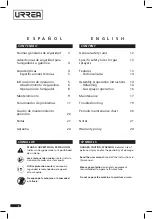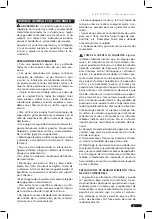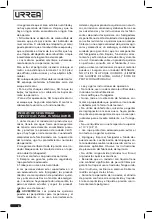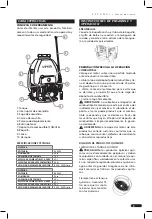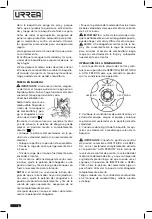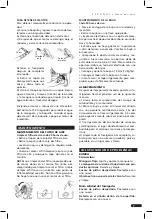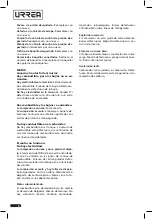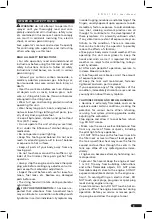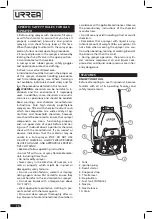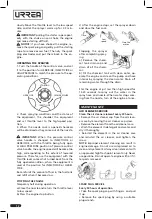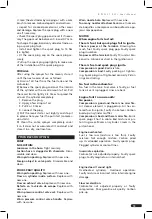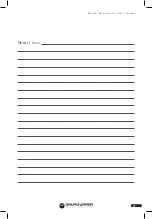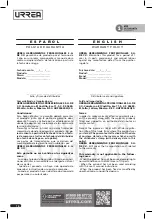
13
E N G L I S H •
User's Manual
• Clean the electrodes by scraping or with a wire
brush to remove carbon deposits and wetness.
• Inspect for cracked porcelain or other wear
and damage. Replace the spark plug with a new
one if necessary.
• Check the spark plug gap and reset it if neces-
sary. The gap must be between 0.6 and 0. 7 mm.
To change the gap, bend only side-electrode, us-
ing a spark plug tool.
• Install and tighten the spark plug to 14 Nm
(1.4 kgf/m).
• Fit the spark plug cap on the spark plug se-
curely.
• Pull up the spark plug cap lightly to make sure
of the installation of the spark plug cap.
STORAGE
After using the sprayer for the season, store it
until the next season of use as follows:
A) Drain of all fuel from the fuel tank and the
carburetor.
B) Remove the spark plug and coat the interior
of the cylinder with a small amount of oil. Pull
the recoil starter lightly 2-3 times to spread the
oil over the cylinder completely.
1. Remove the plug
2. Apply a few drops of oil.
3. Pull 2 or 3 times
4. Connect the plug
C) Pull the recoil starter out slightly and stop it
in place where you fuel the pull start (compres-
sion starts).
D) Clean the entire sprayer completely, cover
it so it does not accumulate dirt and dust and
store it in a dry, cool location.
TROUBLESHOOTING
PUMP
NO SUCTION:
Looseness in the hose. Tight securely.
Suction hose is clogged with chemicals. Disas-
semble and clean.
Worn piston packing. Replace with new one.
Foreign object in valve parts. Disassemble and
clean.
POOR SPRAY QUALITY:
Worn piston packing. Replace with new one.
Flaw on cylinder inside surface. Replace with
new one.
Flaw on exhaust valve. Replace with new one.
Defecto en la válvula de escape. Replace with
new one.
Worn pressure control valve set. Replace with
new one.
Worn pressure control valve handle. Replace
with new one.
Worn nozzle hole. Replace with new one.
Too many nozzles attached. Reduzca el número
de boquillas o reemplace con boquillas de agu-
jeros más pequeños.
MOTOR
When engine fails to start:
There is fuel, but spark plugs fail to ignite.
There is power at the terminal. Drawing too
much fuel. Faulty spark plug gap. Faulty spark
plug insulation.
No power at the terminal. Faulty TCI unit or bro-
ken wire. A break or short in the ignition coil.
There is fuel and spark plugs ignite.
Compression is good. Bad mixture.
Compression is bad. Faulty packing or tighten-
ing. Spark plugs not tightened properly. Piston
rings are sticking.
No fuel in the carburetor:
No fuel in the tank. Fuel valve is faulty, or fuel
tank air vent is plugged. Lines are bent.
Engine fails to run smooth:
No power.
Compression is good and there is no miss fire.
Air cleaner element is plugged up. Air has en-
tered fuel line joints. Faulty choke lever. Carbon
buid-up on cylinder muffler.
Compression is bad, and there is miss fire. Burnt
spark plugs. Short in cable. Bad mixture or pis-
ton ring wear. Marks on cylinder. Cracks in the
piston head.
Engine overheated.
Fuel is too low (mixture is too thin). Faulty
mixture. Not enough mixture. Carbon piled
up. Overloaded operation. Faulty sparks plug.
Plugged cylinder or coolant lines.
Inaccurate explosion.
Carburetor not adjusted properly. Faulty spark
plugs. Faulty magneto or internal short.
Engine doesn’t sound right.
Overheated cylinders. Overload operation.
Faulty mixture or incorrect ratio. Internal engine
damage.
Slow acceleration.
Carburetor not adjusted properly or faulty
compression. Poor gasoline oil quality. Carbon
pile-up.
Summary of Contents for FUMU16
Page 14: ...14 Notas Notes...
Page 15: ...15 Manual de usuario User s manual Notas Notes...


